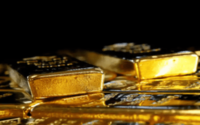US Dollar Exchange Rates and Inflation: What’s Next?
The USD had a heck of a ride, which kept inflation from spiking even further. But it may not last much longer.
By Wolf Richter. This is the transcript of my podcast recorded last Sunday, THE WOLF STREET REPORT.
The US dollar has had one heck of a ride since it became clear that the Federal Reserve would eventually have to start tightening because inflation was beginning to rage.
That inflation was beginning to rage became clear in February 2021. The Federal Reserve, at least in public, brushed it off as transitory, and it came up with all kinds of fake reasons why this was just a blip.
But I was yelling about inflation back then, and I explained why it wasn’t transitory, and why it wasn’t a blip, and lots of people were yelling about it and explaining why it wasn’t transitory, and certain corners of the markets knew that it wasn’t transitory. And we who were screaming about inflation at the time, we all knew that the Fed would eventually crack down on inflation, would have to crack down on inflation, and it would do so by tightening its monetary policy. It would end its asset purchases, it would hike interest rates, and it would start quantitative tightening.
And the currency markets knew it too.
In February 2021 – that infamous February when many of the crappiest stocks peaked and then collapsed by 80% or 90% – in that February 2021, the US dollar made a U-turn against the big currencies that are traded freely, including the euro and the yen.
At the time, so back in February 2021, it took $1.20 to buy €1. Since then, the dollar has surged against the euro. On Friday morning, it took just about exactly $1 to buy €1. The last time this “parity” occurred was in 2002.
The dollar has also surged against the Japanese yen. On Friday, it took over ¥136 to buy one dollar. The exchange rate has been around 136 since late June. You have to go back to the late 1990s to find those exchange rates.
The Federal Reserve maintains a broad dollar index that includes the currencies of the 22 largest trading partners of the US, so not only the euro and the yen, but also the Chinese renminbi, the Mexican peso, the Hong Kong dollar, the Canadian dollar, the Brazilian real, the Thai Baht, etc. 22 of them.
For this broad dollar index, the currencies are weighted by the trade volume with the US. And there is an inflation adjusted version of this broad dollar index, the so-called “Real Broad Dollar Index.” This index goes back to 2006, and by the end of June it had spiked to the highest level since the beginning of the index. Since February 2021, it gained nearly 11%.
The dollar’s sharp rise since February last year has had a significant impact on inflation because we’ve been running a huge trade deficit in goods with the rest of the world. This trade deficit spiked to an all-time high in the first quarter this year.
Import prices shot up too, but the strong dollar has softened the price spike of those imports. In the Eurozone and in Japan, their beaten-down currencies have caused import prices to surge even more than in the US.
So the strong dollar has helped contain the raging inflation in the US. This raging inflation, which has been over 8% for the past few months, based on the Consumer Price Index, would have been higher if the dollar hadn’t gained that much strength since February 2021, when this raging inflation started.
The US produces a lot of commodities, including crude oil, petroleum products, and natural gas, and food commodities, and metals, etc. But it imports a huge amount of high value goods, including gobs of consumer goods, from cellphone to cars, and components, electronic products, industrial products, appliances… you name it.
For example, Boeing’s troubled 787 Dreamliner is assembled in the US, but many of the parts and components are manufactured in countries around the world and are imported. Automakers that assemble vehicles in the US import many components from other countries. This is on top of the large volume of high-dollar finished products that are imported.
This is how the US gets to have this huge gigantic trade deficit – and those goods are paid for in dollars, and when the dollar strengthens, it reduces the bite of price increases that are now cascading around the world.
The exchange rate, such as the dollar versus the euro, is a result of market action in the vast currency market. Currencies are traded against each other, and there is a huge amount of speculation going on, including with currency-based derivatives and hedging, from retail day-traders on up to gigantic trading houses. And so exchange rates fluctuate from one second to the next.
Then there is a separate action that impacts currencies and everything denominated in those currencies, and that is inflation. Inflation reduces the purchasing power of that currency in its own country. The dollar’s purchasing power in the US has been getting whacked by this raging inflation. Everyone knows what this means: you have to pay more dollars for goods and services that you’re buying.
These two dynamics – the exchange rates and the purchasing power of the currencies in their own countries – don’t necessarily move in the same direction short term. Exchange rates are determined by trading in the massive currency market. Inflation has other causes.
So why has the dollar been surging against the euro and the yen when there is so much inflation in the US?
One, there is now about the same raging inflation in the Eurozone as in the US, and in some Eurozone member states, inflation is much worse, in the double digits, and in a couple, it’s over 20%, which is a horrible number. And even in Japan, inflation is now taking off.
And two, the Fed has been on a tightening path since earlier this year – and now on a fairly aggressive path, with rate hikes of 75 basis points and quantitative tightening. But both the European Central Bank and the Bank of Japan are still maintaining negative interest rates.
The ECB will kick off tightening with the first rate hike this month and a bigger rate hike in September, and with QT. There are now some ECB governors talking about an aggressive rate hike in September. One of them just now said that the ECB should hike by one and a quarter percentage points in September to confront this out-of-control raging inflation in the Eurozone. Which would be huge.
The Bank of Japan for now has vowed to not tighten policies, but that too could change if the yen continues to skid lower. Japan is already running a big trade deficit, in part due to the plunge of the yen, that makes imports a lot more expensive, and Japan imports a huge amount in energy commodities, food commodities, other materials, and lots of components, and finished goods, including consumer electronics, and all kinds of stuff.
So central bank tightening is generally supportive of the exchange rate of the currency, and the Fed got there long before the ECB will get there, and the Bank of Japan is still stuck in its old ways.
The Bank of Japan might eventually be compelled to follow. All other major trading partners of the US, except China, have already embarked on rate hikes, and massive rate hikes in some cases, such as Brazil.
And this tightening drama in other countries will eventually start to impact the exchange rates, and the dollar might then reverse and lose ground again.
Hedge fund manager Stanley Druckenmiller said about a month ago, that early tightening by the Fed boosted the dollar but that there’s nothing exceptional about the US economy, and he added, “I will be surprised if sometime in the next six months I’m not short the dollar.”
The dollar is trading at precariously high levels. And historically, when it traded at precariously high levels against other major currencies, it got knocked back down. And sometimes by a lot.
And this is likely to happen again at some point, maybe not tomorrow, or in July or in August, but it’s likely to happen as the ECB starts trying to catch up with the Fed.
There would be nothing special about the dollar reverting to the middle of the 20-year trading range against the major currencies. It has done that before. And in the past, it overshot on the way down.
And if the dollar’s exchange rate reverts back to the middle of the range, or lower, then something else will happen automatically: It will remove the lid that the strong dollar had put on inflation.
A weaker dollar will throw some new fuel on inflation in the US via import prices – particularly high-value finished goods and components. And just when inflation in durable goods might be abating, then there will be this new fuel thrown on top of it – a weaker dollar.
The exchange rate has a delayed impact on pricing of imported goods. Many of these prices are negotiated in dollars months in advance, so a weaker dollar would feed only gradually into consumer price inflation in the US, and it might happen later this year and then more intensively next year. Just when people expect that inflation in durable goods would somehow peter out, there would suddenly be additional fuel for more inflation.
It’s unlikely that this raging inflation will somehow quickly subside below 5%, now that inflation has gotten solidly entrenched in services, where nearly two-thirds of consumer spending ends up. These year-over-year CPI rates fluctuate, they always do, and sometimes by quite a bit, but just when they look like they’re headed back into the acceptable range, they resume surging.
And we’re going to see some of that, we’re going to see CPI rates drop some, and then they will resurge, and there will be lots of reasons for it, but part of the resurgence will be due to the dollar as it loses ground against other major currencies.
You can subscribe to THE WOLF STREET REPORT on YouTube or download it wherever you get your podcasts.
Enjoy reading WOLF STREET and want to support it? Using ad blockers – I totally get why – but want to support the site? You can donate. I appreciate it immensely. Click on the beer and iced-tea mug to find out how:

Would you like to be notified via email when WOLF STREET publishes a new article? Sign up here.
![]()
[ad_2]
Source link


